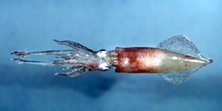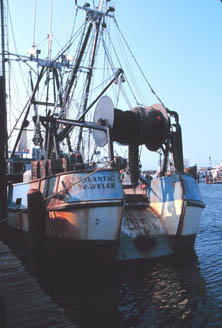Longfin Inshore Squid (Atlantic Loligo) (Loligo pealeii)
- Longfin squid population levels are high, and overfishing is not occurring.
- The longfin squid fishery is managed using several methods that include an annual catch quota, a minimum codend mesh size (for nets), and a limited access permit program.
- Squid are an excellent source of selenium, riboflavin, and vitamin B12. For more on nutrition, see Nutrition Facts. (USDA)
- The majority of the world's catch of longfin squid comes from the waters of the northwest Atlantic Ocean. (FAO)
|
 |
 |
 |
 |
| Nutrition Facts |
| Servings 1 |
| Serving Weight
100g |
 |
| Amount Per Serving |
 |
| Calories 92 |
 |
| Total Fat |
1.38 g |
 |
| Total Saturated Fatty Acids |
0.358 g |
 |
| Carbohydrate |
3.08 g |
| Sugars |
0 g |
| Total Dietary
Fiber |
0 g |
 |
| Cholesterol |
233 mg |
 |
| Selenium |
44.8 mcg |
 |
| Sodium |
44 mg |
 |
| Protein |
15.58 g |
 |
|
 |
 Offloading squid from the fishing vessel Atlantic Traveler at Co-op Seafood Market dock in New Jersey. Offloading squid from the fishing vessel Atlantic Traveler at Co-op Seafood Market dock in New Jersey.
|
 |
Did you know?
The longfin squid swims in large schools during the day but is also known to rest on the seabed.
Squid are aggressive hunters and can consume fish larger than their own body size. A school of squid may decimate an entire school of herring, leaving only heads and tails in their wake. Squid are also cannibalistic.
Like most cephalopods, longfin squid are likely color blind, but are able to use special pigment cells, called chromatophores, in their skin to undergo elaborate color displays and patterning for visual signaling.
|
|
| |
 |
|
Longfin squid have large eyes on their head which are covered by a cornea.
|
 |
|
The fishing vessel Atlantic Traveler squid rigged at the Co-op Seafood Retail Market in New Jersey. Longfin are fished with otter trawls, pound nets, and traps.
|
|
Sustainability Status
Biomass: Estimates of biomass required to support maximum sustainable yield are currently not available.
Overfishing: No
Overfished: No
Fishing and habitat: The fishery is dominated by small-mesh bottom trawlers that fish throughout the year (inshore during spring through early fall and offshore during the rest of the year). Near-shore pound net and fish trap fisheries also occur during spring and summer when the squid migrate inshore to spawn.
Bycatch: In the small-mesh longfin squid fishery, there is bycatch of marine mammals and large pelagic species, including pilot whales, common dolphin, swordfish, and a variety of shark, ray, and tuna species. The main commercial species that are discarded in the fishery include butterfish, red hake, Illex squid, fluke, herring, spiny dogfish, silver hake, and Atlantic mackerel. Amendment 10 of the FMP will address bycatch reduction of butterfish (an overfished stock) and other species in the longfin squid fishery.
Aquaculture: There is currently no commercial aquaculture of longfin squid in the U.S., but this species is reared in the laboratory for research purposes.
|
Science and Management
Throughout its range in the Northwest Atlantic Ocean, longfin squid is considered to be one stock and is managed by the Mid-Atlantic Fishery Management Council under the Atlantic Mackerel, Squid, and Butterfish Fishery Management Plan (FMP). The most recent amendment to the FMP is Amendment 10, which is under development and is expected to consider reducing bycatch of butterfish (an overfished stock) and other finfish in the longfin squid fishery. Current management measures for longfin squid include a minimum codend mesh size of 1 7/8 inches and a total allowable catch (TAC) that is divided into trimester quotas. When 90 percent of the quota for trimesters 1 and 2, or 95% of the annual quota is caught, the directed fishery is closed and an incidental catch of 2,500 pounds per trip is allowed. The TAC is adjusted annually and was set at 17,000 metric tons during 2001-2008. The fishery is also a limited access permit program – only qualifying squid vessels can fish for longfin squid. Vessels that do not qualify for limited access permits can be issued an incidental catch permit.
|
Life History and Habitat
Life history, including information on the habitat, growth, feeding, and reproduction of a species, is important because it affects how a fishery is managed. Longfin squid grow rapidly and have a short, sub-annual life span which makes the species especially vulnerable to recruitment overfishing (when fishing pressure is too heavy to allow a fish population to replace itself).
- Geographic range: Longfin squid are found in continental shelf waters between Newfoundland and the Gulf of Venezuela. In the northwest Atlantic Ocean, specifically, longfin squid are commercially abundant from Georges Bank to Cape Hatteras.
- Habitat: Eggs are found attached to rocks and small boulders or aquatic vegetation on sandy or muddy bottoms. Paralarvae are found in surface waters. Juveniles also inhabit the upper water column in water 165 to 1,650 feet deep. Adults inhabit the continental shelf and upper continental slope to depths up to 1,300 feet. They are found in waters overlying mud or sand/mud substrates. Adults and juveniles exhibit diurnal vertical migration, meaning they can be found nearest the seabed during day and move up into the water column at night.
- Life span: Short - about 9 months.
- Food: Before they feed, longfin squid form large schools based on size. Small immature squid feed on plankton while larger squid feed on crustaceans and small fish. Squid larger than 2 inches are also cannibalistic.
- Growth rate: In general, longfin squid grow rapidly. Males grow faster and reach larger sizes than females. Growth rates are dependent on temperature - individuals hatched in summer grow more rapidly than those hatched in winter.
- Maximum size: Up to 1.6 feet mantle length, although most are less than 1 foot.
- Reaches reproductive maturity: Sexual maturity is first reached at a mantle length of about 3 to 4.7 inches. Half of the population is generally mature at mantle lengths of 6.3 to 7.9 inches, depending on season and location.
- Reproduction: During mating, the male cements bundles of spermatophores into the mantle cavity of the female and/or deposits them in a pouch located near her mouth. Following mating, the spermatophores penetrate the egg capsules, which contain about 150 to 200 eggs each, as they pass through the oviduct. Females can store sperm from spawning events for later use, so eggs in the same capsule may have multiple fathers from multiple spawning events. Hundreds of egg capsules are laid on the bottom in clusters of 1.6 to 2 feet wide. Each female lays 20 to 30 capsules; the number of eggs spawned per female has been estimated between 950 and 15,900. Eggs hatch between 11 and 26 days, depending on water temperature.
- Spawning season: Year-round, with peaks during winter and summer that vary by region and year.
- Spawning grounds: Inshore during late spring through summer; winter spawning grounds are unknown.
- Migrations: North of Cape Hatteras, squid migrate offshore during late autumn to spend the winter in warmer waters along the shelf edge and slope. They return inshore during the spring where they remain until late autumn.
- Predators: Many open ocean- and bottom-dwelling fish species, marine mammals, and diving birds prey upon juvenile and adult longfin inshore squid.
- Commercial or recreational interest: Commercial
- Distinguishing characteristics: Longfin squid are pink or orange and mottled with brown or purple. The fins are long, at least ½ the length of the mantle. The head has large eyes which are covered by a cornea.
|
Role in the Ecosystem
Longfin squid are an important component of the Northwest Atlantic Ocean ecosystem, as both predator and prey. These roles link them to many commercial fish species, large pelagic finfish, marine mammals, and humans.
|
Additional Information
Market name: Squid, Loligo
Vernacular names: Winter Squid, Boston Squid, Longfin Inshore Squid
|
Biomass
 Biomass refers to the amount of longfin squid in the ocean. Scientists cannot collect and weigh every single squid to determine biomass, so they use models to estimate it instead. These biomass estimates can help determine if a stock is being fished too heavily or if it may be able to tolerate more fishing pressure. Managers can then make appropriate changes in the regulation of the fishery.
Biomass refers to the amount of longfin squid in the ocean. Scientists cannot collect and weigh every single squid to determine biomass, so they use models to estimate it instead. These biomass estimates can help determine if a stock is being fished too heavily or if it may be able to tolerate more fishing pressure. Managers can then make appropriate changes in the regulation of the fishery.
Longfin squid was last assessed in November 2001. Results indicated that quarterly biomass estimates ranged between 14,000 and 27,000 metric tons and averaged 21,800 metric tons during 1987 to 2000. During 2000, average biomass was 24,000 metric tons. However, the stock status determination for 2000 is outdated because longfin squid is a sub-annual species. Relative biomass indices are highly variable interannually. From 1999 to 2002, autumn relative biomass indices were well above the time series average and among the highest levels on record. Relative biomass declined below average levels through 2005, then increased again and was slightly above the long-term average in 2007.
Note: Biomass indices from the Northeast Fisheries Science Center's fall survey are presented in the graph.
Landings
 Landings refer to the amount of catch that is brought to land. Total landings increased sharply from 1,700 metric tons in 1967 to a peak of 37,600 metric tons in 1973. Landings declined to 10,600 metric tons in 1978 and then increased to 23,700 metric tons in 1980. From 1982 to 1989, U.S. fishery landings increased rapidly as offshore domestic fleets developed and quotas were no longer allocated to foreign fleets. Since 1987, landings have been solely from the domestic fisheries and have fluctuated between a low of 10,400 metric tons in 1987 to a high of 23,700 metric tons in 1989. Landings generally declined after 1999, and in 2003, reached the lowest level since 1987. The decline in landings since 1999 was partially due to frequent seasonal closures of the directed fishery. During 2004-2006, landings ranged between 15,600 and 17,000 metric tons and totaled 12,300 metric tons in 2007. Landings refer to the amount of catch that is brought to land. Total landings increased sharply from 1,700 metric tons in 1967 to a peak of 37,600 metric tons in 1973. Landings declined to 10,600 metric tons in 1978 and then increased to 23,700 metric tons in 1980. From 1982 to 1989, U.S. fishery landings increased rapidly as offshore domestic fleets developed and quotas were no longer allocated to foreign fleets. Since 1987, landings have been solely from the domestic fisheries and have fluctuated between a low of 10,400 metric tons in 1987 to a high of 23,700 metric tons in 1989. Landings generally declined after 1999, and in 2003, reached the lowest level since 1987. The decline in landings since 1999 was partially due to frequent seasonal closures of the directed fishery. During 2004-2006, landings ranged between 15,600 and 17,000 metric tons and totaled 12,300 metric tons in 2007.
Note: U.S. commercial landings are shown in the graph.
Biomass and Landings
 Are landings and biomass related? Landings are dependent on biomass, management measures in the fishery, and fishing effort.
Are landings and biomass related? Landings are dependent on biomass, management measures in the fishery, and fishing effort.
Data sources:
Biomass and landings from NEFSC Status of Fishery Resources off the Northeastern U.S. - Longfin inshore squid
|
Important Dates
Late 1800s – U.S. squid fishery begins as a source of bait
1964-1984 – Foreign fleets dominate landings
1973 – Landings peak at 37,600 metric tons; inshore domestic trawl fishery develops but landings are only several thousand metric tons
1978 – Total landings decline to 10,600 metric tons
1978-1979 – Original FMP implemented to manage squid
1980 – Landings increase to 23,700 metric tons
1982-1989 – U.S. fishery landings increase rapidly as offshore domestic fleets develop and quota allocations for distant water fleets are phased out
1987 – Squid fishery is entirely domestic; landings are 10,400 metric tons
1989 – Domestic landings reach high of 23,700 metric tons
1996 – Amendment 5 eliminates directed foreign fishing for squid, implements a limited access system, institutes a dealer and vessel reporting system and an operator permitting system, and adjusts the maximum sustainable yield for squid
2005 – Landings total 17,000 metric tons
2008 – Amendment 9 is developed, updating Loligo biological reference points and designated essential fish habitat for Loligo eggs
|
Notes and Links
General Information:
Longfin Inshore Squid, Loligo pealeii, Life History and Habitat Characteristics
Fishery Management:
Mid-Atlantic Fishery Management Council
Amendment 9 to the Atlantic Mackerel, Squid, and Butterfish Fishery Management Plan (FMP)
Summary of the history of the Atlantic Mackerel, Squid, and Butterfish FMP
Stock Assessments:
34th Northeast Regional Stock Assessment Workshop - April 2002
NEFSC Status of Fishery Resources off the Northeastern U.S. - Longfin inshore squid
|
| |
|



